纽马克的翻译理论
简析纽马克的语义翻译和交际翻译理论
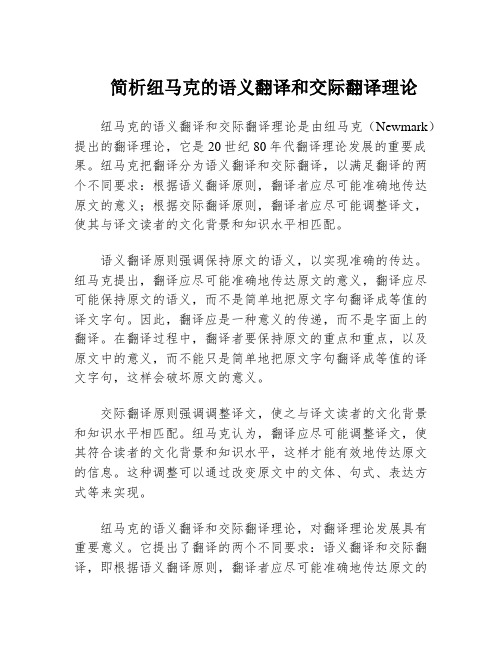
简析纽马克的语义翻译和交际翻译理论纽马克的语义翻译和交际翻译理论是由纽马克(Newmark)提出的翻译理论,它是20世纪80年代翻译理论发展的重要成果。
纽马克把翻译分为语义翻译和交际翻译,以满足翻译的两个不同要求:根据语义翻译原则,翻译者应尽可能准确地传达原文的意义;根据交际翻译原则,翻译者应尽可能调整译文,使其与译文读者的文化背景和知识水平相匹配。
语义翻译原则强调保持原文的语义,以实现准确的传达。
纽马克提出,翻译应尽可能准确地传达原文的意义,翻译应尽可能保持原文的语义,而不是简单地把原文字句翻译成等值的译文字句。
因此,翻译应是一种意义的传递,而不是字面上的翻译。
在翻译过程中,翻译者要保持原文的重点和重点,以及原文中的意义,而不能只是简单地把原文字句翻译成等值的译文字句,这样会破坏原文的意义。
交际翻译原则强调调整译文,使之与译文读者的文化背景和知识水平相匹配。
纽马克认为,翻译应尽可能调整译文,使其符合读者的文化背景和知识水平,这样才能有效地传达原文的信息。
这种调整可以通过改变原文中的文体、句式、表达方式等来实现。
纽马克的语义翻译和交际翻译理论,对翻译理论发展具有重要意义。
它提出了翻译的两个不同要求:语义翻译和交际翻译,即根据语义翻译原则,翻译者应尽可能准确地传达原文的意义;根据交际翻译原则,翻译者应尽可能调整译文,使其与译文读者的文化背景和知识水平相匹配。
它的出现,被认为是翻译理论发展的一个重要里程碑,它为翻译理论的发展提供了一个新的视角,引发了翻译理论发展的新思想和新活动。
综上所述,纽马克的语义翻译和交际翻译理论对翻译理论发展具有重要意义,它提出了翻译的两个不同要求:语义翻译和交际翻译,以满足翻译的两个不同要求:根据语义翻译原则,翻译者应尽可能准确地传达原文的意义;根据交际翻译原则,翻译者应尽可能调整译文,使其与译文读者的文化背景和知识水平相匹配。
它的出现,被认为是翻译理论发展的一个重要里程碑,它为翻译理论的发展提供了一个新的视角,引发了翻译理论发展的新思想和新活动,为翻译理论发展提供了新的借鉴和参考。
PeterNewmark西方翻译理论

B. 在表达形式上,语义翻译是译文与原文 的形式更为接近,并尽量保留原文的声 畅地道, 简明易懂。
C.当信息的内容与效果发生矛盾时,语 义翻译重内容而不重效果,交际翻译则 重效果轻内容。
e.g.
Wet Paint! 湿油漆! 油漆未干,请勿触摸!
the letter --- the spirit
the words --- the sense
form --- message 他认为直译和意译都忽视了翻译应当 考虑翻译目的、读者的特点和文本的类 型。
各种翻译方法的差异:
SL emphasis
TL emphasis
Word-for-word translation
直译 原文语言形式
意译 译文语言形式
语义翻译法集逐字翻译、直译和忠实 翻译的优势
交际翻译集归化、意译和地道翻译的优 势
理论基础
理论论述 以德国心理学家、功能语言学家布勒
和雅各布森论述的三大语言功能为依据, 即表情功能、信息功能、感染功能。还 采用了弗哥茨基(Vygotsky)关于思维 的本质的观点来区分两种翻译:
“内心言语本身就是一种功能,而不是外在言语
的内在表现。在很大程度上,内心言语才是纯 粹意义上的思维。”
据此,纽马克认为成年人运用语言的目 的和运用语言进行的最基本的活动是思 维,而不是说话或写作、交际或(自我) 表达。
A.每个人在思考的时候,总会有单词或句 子出现在脑海里,而不可能只是一片空 白。这说明,语言能表明人在思考,但 语言不等同于思维。
一、生平 二、主要理论
一、生平
彼得·纽马克,生于1916 年,是英国著名的翻译家 和翻译理论家。他从事过 多种欧洲语言的翻译工作, 是出色的译者和编辑。纽 马克同时也是一位语言学 家,并担任英国语言学家 协会会长。他的主要兴趣 就是把语言学的相关理论 应用于翻译实践之中,把 翻译研究和英语语言研究 相结合。
纽马克的文本类型理论及翻译方法探究

纽马克的文本类型理论及翻译方法探究导语:尼德兰语学者纽马克(Eddy Verheul Newmark)是当代翻译学界的重要研究者之一,他提出了著名的“纽马克翻译理论”。
本文将探讨纽马克的文本类型理论以及翻译方法,并分析其对翻译实践的启示。
一、纽马克的文本类型理论纽马克的文本类型理论是其翻译理论的核心之一。
他认为不同的文本类型具有不同的翻译策略和技巧,因此翻译时需根据文本类型的特点进行相应的处理。
1. 叙述性文本叙述性文本着重于叙述事件、事实和观点。
在翻译时,翻译者应尽量保持原文的逻辑结构和语气,忠实地再现原文的内容。
同时,应注意调整句子的顺序和篇章的连贯性,以符合目标语言的表达习惯。
2. 描述性文本描述性文本主要描述事物、情景和形象等。
纽马克建议翻译者通过运用形象化的语言,尽量呈现原文中的感官体验和形象感受。
同时,在翻译时也需注意调整句子的结构和修辞手法,以符合目标语言读者的理解习惯。
3. 说明性文本说明性文本是指介绍和解释事物的文本类型。
在翻译说明性文本时,翻译者应确保准确传达原文中的信息,尽量保持说明的准确性和简明性。
此外,还需注意适应目标语言读者的认知和文化背景,确保翻译结果易于理解。
4. 议论性文本议论性文本强调作者对事物的看法和观点。
在翻译时,翻译者应尽量保持原文的立场和态度,并通过合适的修辞手法和语气来传达原文中的说服力。
同时,也需注意平衡原文的长短句和逻辑关系,以保持翻译的连贯性和流畅度。
二、纽马克的翻译方法除了文本类型理论,纽马克还提出了一些翻译的实用方法,有助于提高翻译的质量和效率。
1. 直译和意译的运用直译是指尽量保持源语言的结构和表达方式,逐词逐句地翻译。
而意译则是根据目标语言的习惯和表达方式,对源语言进行适当的调整和变化。
纽马克认为,翻译时应根据具体的情况灵活运用直译和意译,以保持翻译的准确性和自然度。
2. 文化因素的考虑纽马克强调文化对翻译的重要性。
在翻译时,翻译者需要了解源语言和目标语言的文化背景,并将其考虑到翻译过程中。
彼得纽马克翻译新观念概述
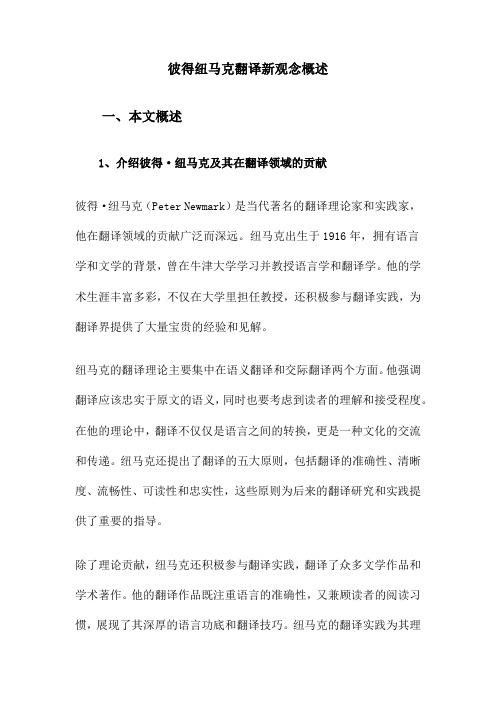
彼得纽马克翻译新观念概述一、本文概述1、介绍彼得·纽马克及其在翻译领域的贡献彼得·纽马克(Peter Newmark)是当代著名的翻译理论家和实践家,他在翻译领域的贡献广泛而深远。
纽马克出生于1916年,拥有语言学和文学的背景,曾在牛津大学学习并教授语言学和翻译学。
他的学术生涯丰富多彩,不仅在大学里担任教授,还积极参与翻译实践,为翻译界提供了大量宝贵的经验和见解。
纽马克的翻译理论主要集中在语义翻译和交际翻译两个方面。
他强调翻译应该忠实于原文的语义,同时也要考虑到读者的理解和接受程度。
在他的理论中,翻译不仅仅是语言之间的转换,更是一种文化的交流和传递。
纽马克还提出了翻译的五大原则,包括翻译的准确性、清晰度、流畅性、可读性和忠实性,这些原则为后来的翻译研究和实践提供了重要的指导。
除了理论贡献,纽马克还积极参与翻译实践,翻译了众多文学作品和学术著作。
他的翻译作品既注重语言的准确性,又兼顾读者的阅读习惯,展现了其深厚的语言功底和翻译技巧。
纽马克的翻译实践为其理论提供了有力的支撑,同时也为翻译界树立了榜样。
彼得·纽马克是翻译领域的一位杰出人物,他的理论和实践成果为翻译研究和实践提供了宝贵的指导和借鉴。
他的贡献不仅体现在翻译理论的发展上,更体现在其对翻译实践的深刻理解和精湛技艺上。
2、概述文章目的和内容本文旨在全面介绍彼得·纽马克的翻译新观念,旨在帮助读者更好地理解和应用这些观念,以提高翻译质量和效果。
彼得·纽马克是翻译学领域的知名学者,他的翻译理论对翻译实践具有重要的指导意义。
本文将从纽马克的翻译理论出发,探讨其新观念的核心内容,包括翻译的本质、翻译的方法和技巧、翻译的标准和评价等方面。
通过深入剖析这些观念,本文旨在帮助读者建立正确的翻译观念,提高翻译能力,为翻译事业的发展做出贡献。
文章内容将围绕彼得·纽马克的翻译新观念展开,首先介绍其理论背景和发展历程,然后重点阐述其新观念的核心内容。
纽马克的翻译批评理论简析

纽马克的翻译批评理论简析
纽马克的翻译批评理论是一种从语言学、文学理论和社会学个体学的三者视角来对翻译进行检验和质疑的中心思想。
这一理论的核心原则是保留原文的内容。
如果写作者的信息没有完整地被传输到读者那里,那么,翻译就会失败,原文和译文之间就存在着或多或少的偏差。
另外,应当把原文在文化-语言上的特色完整地传输出去,把一种语言重新翻译成另一种语言,却仍然能够令读者得到同样的感受和经历。
在翻译时,应当结合批评性和创造性,充分考虑所有相关文化背景,做出恰当地审美选择,保障读者能够从原文中得到精神引领的体验,而不是仅仅机械的字面翻译,因此,翻译者应当根据不同语境、不同文化背景对原文进行彻底剖析,从而进行相应的翻译工作。
综上所述,纽马克翻译批评理论强调了传播者必须不加改动完整地传输原文内容的重要性,同时也指出翻译中必须考虑文化背景的重要性,而非仅仅机械的字面翻译。
纽马克的翻译理论

• 到底孰个是真正的解人实在无法评断。我们又安 到底孰个是真正的解人实在无法评断。 得起严老先生于地下而询之这恐怕要成为千古疑 案了。正是,妙谛纷纷说到今 妙谛纷纷说到今, 案了。正是 妙谛纷纷说到今 几人探藏得真经就 拿一个“ 字来说吧。 拿一个“ 信”字来说吧。以“ 信”作为翻译的标 对不对呢当然对的。谁也不能否认的, 准, 对不对呢当然对的。谁也不能否认的 因为这 是翻译的本质所决定的不‘ 就不成其为翻译。 是翻译的本质所决定的不‘ 信”就不成其为翻译。 但是“ 是一个抽象的、空洞的概念。 但是“ 信”是一个抽象的、空洞的概念。到底怎 样才算“ 各个翻译家都有不同的看法, 样才算“ 信” 各个翻译家都有不同的看法 因此 就出现了各种不同的翻译方式。 就出现了各种不同的翻译方式。有人认为必须逐 句移译方为信有人认为必须尽可能保持原文的语 言形式, 以至句法结构有人认为可以不顾原文的语 言形式 言形式, 言形式 只要传达原作的意思就行有人认为必须 形神兼似”方为信多有人认为“遗貌取神” “ 形神兼似”方为信多有人认为“遗貌取神”斯 为信。各人的看法不同, 众说纷纭, 为信。各人的看法不同 众说纷纭 莫衷一是在这 一方面, 奈达博士似乎比严老先生就要高明一些, 一方面 奈达博士似乎比严老先生就要高明一些 或者说, 明确一些了。 或者说 明确一些了。
• 严复的“信、达、雅”说, 实际上并没有构成完整 严复的“ 的翻译理论。他老先生当日写《例言》那篇文章, 的翻译理论。他老先生当日写《例言》那篇文章 也并不有志为翻译理论家, 他只是根据他翻译《 也并不有志为翻译理论家 他只是根据他翻译《天 演论》的经验, 谈谈自己的心得体会而已。 演论》的经验 谈谈自己的心得体会而已。所以他 采取的评议方法是随感式、印象式的, 采取的评议方法是随感式、印象式的 是微观的分 析方法, 并没有从宏观的角度, 进行全面的分析研 析方法 并没有从宏观的角度 从而找出客观的规律来。事实上, 究, 从而找出客观的规律来。事实上 象翻译这样 一门牵涉到两个不同民族的语言、文化、思想、 一门牵涉到两个不同民族的语言、文化、思想、 艺术交流的、极其广泛而繁复的学问,要简单地用 艺术交流的、极其广泛而繁复的学问 要简单地用 三个字来概括其理论, 恐怕是有困难的。 三个字来概括其理论 恐怕是有困难的。而况他老 人家又是一位古文大家,行文力求古雅 简练、 行文力求古雅、 人家又是一位古文大家 行文力求古雅、简练、含 言有尽而意无穷” 所以他解释“ 蓄, 要“ 言有尽而意无穷” 。所以他解释“ 信、 达、雅” 三词的涵义, 只有寥寥数语, 而含义深邃, 三词的涵义 只有寥寥数语 而含义深邃 难于窥测, 读者要悉心揣摩, 难于窥测 读者要悉心揣摩 以探测其意旨所在而 各人由于经验和领悟的不同, 各人由于经验和领悟的不同 往往就作出不同的解 释来。所以, 近百年来, 不知有多少人引用“ 释来。所以 近百年来 不知有多少人引用“ 信、 赞颂“ 解释“ 达、雅” , 赞颂“ 信、达、雅” ,解释“ 信、达、 解释 雅” 。
彼得纽马克的所有翻译理论

语义对等性的实现方法
为了实现语义对等性,译者需要深入理解原文的语境、词汇和语法结构,同时还需要考虑目标语言的表达习惯和文化背景。
语义对等性
语义翻译与交际翻译的区别
语义翻译更注重原文的形式和内容,力求保持原文的语义和句法结构,而交际翻译则更注重译文的交际效果,强调译文的流畅性和可读性。
语义翻译与交际翻译的联系
交际翻译的对等性
彼得纽马克认为,交际翻译和语义翻译并不是相互独立的,而是相互补充的。
在翻译过程中,需要根据文本的类型和功能选择适当的翻译方法。对于信息型文本,如新闻报道、科技文献等,应该采用语义翻译方法,以准确地传达原文的信息;对于表达型文本,如诗歌、散文等,应该采用交际翻译方法,以使译文更符合目标语言的表达习惯和文化背景。
04
文化翻译理论
VS
彼得纽马克认为,文化翻译是一种将源语言中的文化信息传达给目标语言读者的过程,其原则包括保持源语言的文化特色、尊重目标读者的文化背景和审美习惯。
详细描述
彼得纽马克认为,文化翻译的主要目的是在目标语言中再现源语言的文化特色和内涵,以促进不同文化之间的交流和理解。为了实现这一目的,文化翻译应遵循以下原则:保持源语言的文化特色,尊重目标读者的文化背景和审美习惯,以及在必要时对原文进行适当的调整或注释。
在实际翻译中,两种方法常常需要结合使用,以确保译文既忠实于原文的内容和风格,又能够有效地传达原文的信息和功能。
01
02
03
交际翻译与语义翻译的关系
优点
交际翻译强调译文的交际效果,能够使译文更符合目标语言的表达习惯和文化背景,使读者更容易理解和接受。同时,交际翻译的对等性要求也提高了译文的准确性和可读性。
直译的定义与原则
直译的原则
纽马克的翻译理论

03
有利于目标语读者理解和感受原文的文化背景和内涵
语义翻译的优缺点
语义翻译的优缺点
01
缺点
02
可能过于强调原文的语义和句法结构,导致 目标语表达不够流畅自然
03
可能过于依赖直译,导致译文失去原文的语 言魅力和文化特色
04
可能过于追求准确性和忠实性,忽略译文的 读者感受和文化差异
要点三
文本类型分析
根据纽马克的翻译理论,译者需要对 原文的文本类型进行分析,根据不同 的文本类型采取不同的翻译策略。例 如,在信息型文本中,译者应注重信 息的准确性和清晰度;在号召型文本 中,译者应注重语言的感染力和说服 力。
在机器翻译中的应用
01
语义理解
纽马克的翻译理论强调语义理解在翻译中的重要性。在机 器翻译中,语义理解是关键,机器需要通过对语言的分析 和理解来生成准确的译文。
THANKS FOR WATCHING
感谢您的观看
在实际翻译过程中,语义翻译和交际翻译并不是互斥的, 而是可以相互补充的。在某些情况下,可以将两种方法结 合使用,以达到更好的翻译效果。
无论是语义翻译还是交际翻译,都需要译者具备扎实的语 言基础、文化背景知识和专业素养,以确保翻译的质量和 准确性。
定义与特点
01
02
定义:语义翻译是指根 据原文的语义、句法结 构和表达方式,使用目 标语的对应词汇和结构 进行翻译,尽可能准确 地传达原文的意义和信 息。
可能牺牲原文的艺术性
在文学作品的翻译中,交际翻译可能过于注重信息的传递而牺牲原文的艺术性和审美价值。
文化因素难以完全传递
由于文化差异的存在,交际翻译在传递原文文化因素时可能会遇到困难,难以完全准确地传递文化信 息。
简析纽马克的语义翻译和交际翻译理论

简析纽马克的语义翻译和交际翻译理论一、本文概述本文旨在深入简析纽马克(Nida Eugene Albert Nida)的语义翻译和交际翻译理论,探讨其在翻译实践中的应用与影响。
纽马克是西方翻译理论界的杰出代表,其提出的语义翻译和交际翻译理论对翻译学研究产生了深远影响。
本文首先将对纽马克的理论进行概述,介绍其基本概念和核心思想。
随后,文章将详细分析语义翻译和交际翻译的特点、优势与局限,以及两者在实际翻译操作中的平衡与选择。
本文还将通过具体案例,探讨纽马克理论在文学、商务、法律等领域翻译实践中的应用,以期对翻译实践提供有益指导。
文章将总结纽马克理论对翻译学的贡献,并展望其未来的发展趋势。
通过本文的论述,读者将能够更全面地了解纽马克的语义翻译和交际翻译理论,为翻译实践提供理论支持和实践指导。
二、纽马克的翻译理论背景纽马克(Eugene A. Nida)是20世纪最著名的翻译理论家和实践者之一,他以其独特的翻译理论和方法在翻译界产生了深远的影响。
他的翻译理论主要基于两个核心概念:语义翻译(semantictranslation)和交际翻译(communicative translation)。
这两个概念不仅为翻译实践提供了指导,也为翻译理论研究开辟了新的路径。
纽马克的翻译理论背景可以追溯到他对语言学、语用学和跨文化交际学的深入研究。
他认为,翻译不仅仅是语言之间的转换,更是一种跨文化交际行为。
因此,翻译者不仅要关注语言的准确性,还要考虑读者的文化背景和接受能力。
在这一思想指导下,他提出了语义翻译和交际翻译两种翻译方法。
语义翻译强调保持原文的语义内容和句法结构,尽可能传达原文的语境意义。
这种翻译方法适用于那些重视原文形式、结构和修辞的文本,如文学作品、科技论文等。
而交际翻译则更注重译文的可读性和可接受性,旨在使译文读者能够像原文读者一样理解和欣赏原文。
这种翻译方法适用于那些以信息传递和沟通为主要目的的文本,如新闻报道、广告、公文等。
浅析纽马克的翻译理论
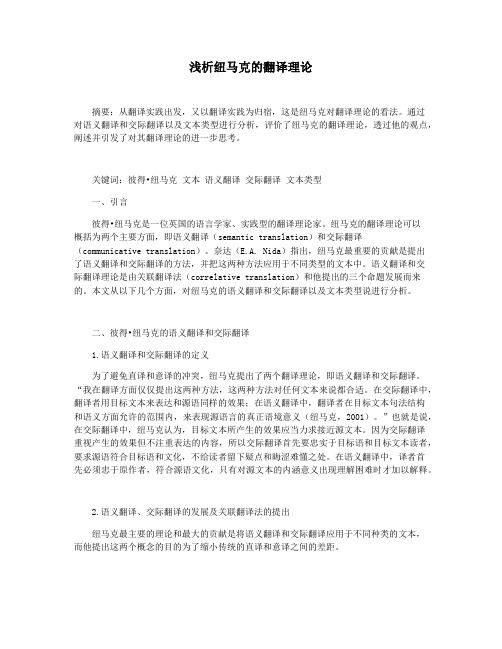
浅析纽马克的翻译理论摘要:从翻译实践出发,又以翻译实践为归宿,这是纽马克对翻译理论的看法。
通过对语义翻译和交际翻译以及文本类型进行分析,评价了纽马克的翻译理论,透过他的观点,阐述并引发了对其翻译理论的进一步思考。
关键词:彼得•纽马克文本语义翻译交际翻译文本类型一、引言彼得•纽马克是一位英国的语言学家、实践型的翻译理论家。
纽马克的翻译理论可以概括为两个主要方面,即语义翻译(semantic translation)和交际翻译(communicative translation)。
奈达(E.A. Nida)指出,纽马克最重要的贡献是提出了语义翻译和交际翻译的方法,并把这两种方法应用于不同类型的文本中。
语义翻译和交际翻译理论是由关联翻译法(correlative translation)和他提出的三个命题发展而来的。
本文从以下几个方面,对纽马克的语义翻译和交际翻译以及文本类型说进行分析。
二、彼得•纽马克的语义翻译和交际翻译1.语义翻译和交际翻译的定义为了避免直译和意译的冲突,纽马克提出了两个翻译理论,即语义翻译和交际翻译。
“我在翻译方面仅仅提出这两种方法,这两种方法对任何文本来说都合适。
在交际翻译中,翻译者用目标文本来表达和源语同样的效果;在语义翻译中,翻译者在目标文本句法结构和语义方面允许的范围内,来表现源语言的真正语境意义(纽马克,2001)。
”也就是说,在交际翻译中,纽马克认为,目标文本所产生的效果应当力求接近源文本。
因为交际翻译重视产生的效果但不注重表达的内容,所以交际翻译首先要忠实于目标语和目标文本读者,要求源语符合目标语和文化,不给读者留下疑点和晦涩难懂之处。
在语义翻译中,译者首先必须忠于原作者,符合源语文化,只有对源文本的内涵意义出现理解困难时才加以解释。
2.语义翻译、交际翻译的发展及关联翻译法的提出纽马克最主要的理论和最大的贡献是将语义翻译和交际翻译应用于不同种类的文本,而他提出这两个概念的目的为了缩小传统的直译和意译之间的差距。
奈达与纽马克翻译理论比较

奈达与纽马克翻译理论比较一、本文概述本文旨在深入比较和分析奈达(Eugene Nida)与纽马克(Newmark)的翻译理论,揭示两者在翻译理念、方法和实践上的异同。
奈达和纽马克都是翻译领域的杰出学者,他们的理论对现代翻译实践产生了深远的影响。
奈达以其“动态对等”理论著称,强调翻译应以读者为中心,追求原文和译文在语义和风格上的对等。
而纽马克则提出了“语义翻译”和“交际翻译”的概念,主张根据文本类型和翻译目的选择合适的翻译方法。
本文首先概述奈达和纽马克的主要翻译理论,包括其核心理念、关键术语和具体应用。
通过对比分析,揭示两者在翻译理论上的共性和差异,探讨这些差异如何影响翻译实践。
本文还将评估这两种理论在现代翻译实践中的适用性,并探讨其未来发展方向。
通过本文的比较研究,读者能够更全面地了解奈达和纽马克的翻译理论,理解它们在现代翻译实践中的价值,并为今后的翻译研究和实践提供有益的启示。
二、奈达翻译理论概述奈达(Eugene Nida)是当代西方翻译理论界极具影响力的人物,他提出的翻译理论被誉为“功能对等”或“动态对等”理论。
奈达的翻译理论主要基于两个核心概念:形式对等(formal equivalence)和动态对等(dynamic equivalence)。
形式对等,也被称为字面对等,指的是译文尽可能地复制原文的语言形式,包括词汇、语法、句子结构等。
奈达认为,这种对等方式主要适用于那些具有重大历史、文化和文学价值的文献翻译,因为这些文献的语言形式本身就是其意义的重要组成部分。
然而,奈达更加强调的是动态对等,也就是译文应该在传达原文语义和风格上达到对等,而不是在语言形式上。
他认为,翻译的主要目的是使译文读者能够像原文读者一样理解和欣赏原文,因此,翻译过程中应当考虑到译文读者的语言习惯和文化背景。
为了实现动态对等,奈达提倡译者在翻译过程中进行适当的调整和重构,包括词汇选择、句子结构、修辞手法等方面的调整。
PeterNewmark西方翻译理论

3 translation of metaphor by simile 用明喻 代替隐喻, 保留喻体
e.g.They crowded around him and the flood of questions came.
他们围着他,问题想潮水般涌来。
4 translation of metaphor or simile by simile plus sense 用明喻和喻底结合翻译隐喻
B.当一个人在听他人说话的时候,总是在 “思考”,否则,他就是在脑海里一片空白 的情况下去理解他人的话,而这是根本不 可能的。
C.人绝大多数时候都在进行思考。
与语义和交际翻译法的关系:
文本是书写的产物,有些文本以表达 作者的思想为主,语言的表达功能占据了 主导地位,信息功能退居其次,而社会人际 功能根本就不起作用,这时候一般就采取 语义翻译,即语义翻译多用于文本与思维 过程关系紧密相关,而且思维的每一个环 节都很重要的情况。
各种翻译方法的差异:
SL emphasis
TL emphasis
Word-for-word translation
Adaptation
Literal translation
Free translation
Faithful translation Idiomatic translation
Semantic translation municative
F.语义翻译是一门艺术,只能由一个人单独承担, 不能有不准确的翻译,但由于造成了认知意义和 语用意义的走失,语义翻译译文一般不及原文。
交际翻译是一门技巧,有时可由多人承担。由于 重效果,简洁明了,弥补了语义翻译中意义的走 失,又经过了适当的润色,交际翻译译文一般优 于原文。
Peter Newmark 西方翻译理论

(1)理论背景
(2)理论基础
(3)定义 (4)比较 (5)再发展
理论背景
直译 意译
语义翻译 交际翻译
F.语义翻译是一门艺术,只能由一个人单独承 担,不能有不准确的翻译,但由于造成了认知
意义和语用意义的走失,语义翻译译文一般不
及原文。
交际翻译是一门技巧,有时可由多人承担。由
于重效果,简洁明了,弥补了语义翻译中意义
的走失,又经过了适当的润色,交际翻译译文
一般优于原文。
适用文本
语义翻译:表达性文本或是重要的审美 性文本,其表达形式和内容一样重要, 那么不管是文学作品,还是哲学、宗教、 政治、科技作品都用语义翻译。
Bao-yu played “Racing Go”with the other maids. This was a game in which you moved your Gopieces across the board in accordance with the throw of dice, the object being to reach the opposite side before every thing else and pocket all the stakes.(David Hawkes &John Minford)
“内心言语本身就是一种功能,而不是外在言语
的内在表现。在很大程度上,内心言语才是纯
粹意义上的思维。”
据此,纽马克认为成年人运用语言的目 的和运用语言进行的最基本的活动是思
纽马克——文本类型及翻译理论
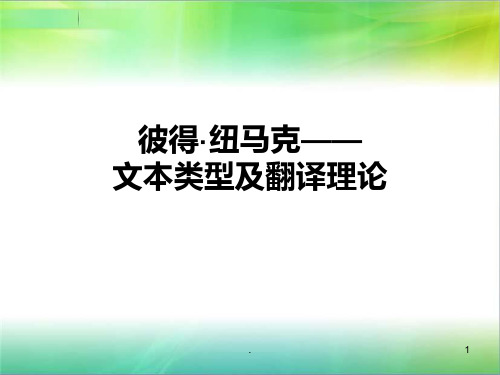
.
6
二、语义翻译(Semantic Translation)和 交际翻译(Communicative Translaion)
• 语义翻译:目标文本应在目标语的语义和句法结构允许的 情况下尽可能准确地再现原文本的语境意义。(即以源语 为依归,更多的考虑源语的美学因素。)
• 交际翻译:试图对译文读者产生一种效果,这效果要尽可 能接近原作对原文读者所产生的效果。(即以读者能够理 解和接受的方式翻译,重现原文的内容和上下文意义。)
彼得·纽马克—— 文本类型及翻译理论
.
1
彼得·纽马克
• 英国著名的翻译家和翻译理论家,是语言学派的代表 人物。
• 《翻译问题探讨》(Approaches to Translation) • 在《翻译问题探讨》一书中,纽马克根据不同的内容
和文体,将文本主要分为表达功能型文本、信息功能 型文本和号召功能型文本;而针对不同的文本类型, 应当采用不同的翻译方法——语义翻译或交际翻译。
• 典型的表达型文本有:①严肃的、富有想象力的文学作品 ②权威性言论③作者个人情感的一种宣泄,或无直接读者 群的文本
• 表达功能型文本强调原作者的权威,在翻译时要遵循“原 作者第一”的原则,既要忠实于原作者表达的思想内容, 又要忠实于原作者的语言风格,无需考虑目标语读者的反 应。
.
4
(二)信息功能
• 语言信息功能的核心是外部情况,即一个话题的全部信息 ,或者说言语之外的现实情况。
• 信息型文本可以涉及任何知识领域,如工、农、商、教育 、科技、经济等方面,其形式往往非常标准化。
• 信息型文本的核心是内容的“真实性(Authenticity)”,作 者的语言是次要的。在翻译时应遵循“真实性第一”的原 则。译者在语言应用上可以不以原作为标准,而以目标语 读者的语言层次为标准,力求通顺易懂。
奈达与纽马克翻译理论比较
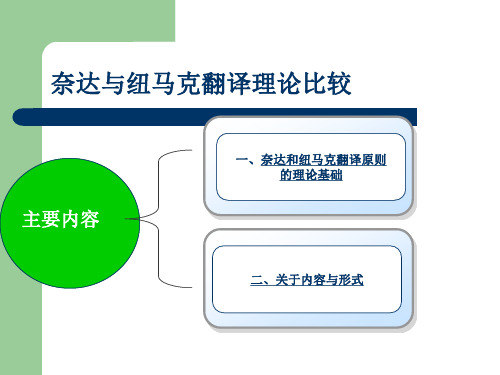
动态对等/功能对等
指翻译时不求文字表面的死板对应,而要在 两种语言间达成功能上的对等,是用最切近、 自然和对等的语言从语义到文体再现源语的 信息。 翻译不仅是词汇意义上的对等,还包 括语义、风格和文体的对等,翻译传达的信 息既有表层词汇信息,也有深层的文化信息.
动态对等/功能对等
奈达功能对等理论认为,在翻译过程中,为了 达到原文本与译本功能对等,可以采取一定的 方式弥补或调整。奈达还认为功能对等不是严 格意义上的逐字或逐句对等。“功能对等”理 论是一种比较客观的等效翻译理论,它追求译 文的效果,强调译文读者对译文的反应要基本 上与原文读者对原文的反应一致,并把这一点 作为评价译文好环的标准.
交际翻译
纽马克承认话语的主要功能是交际, 正如学外 语的主要目的也是为了用来交际, 而不是用来 思考, 因此可以说交际翻译是一种使用更广泛 的翻译方法, 它更能为读者提供信息, 给他们以 劝告或号召他们行动。
语义翻译
指在译入语语义和句法结构允许的可能准确地 再现原文上下文意义及保持原作的语言特色和 独特的表达方式 。
信息论例子
译文:“你打算以后要到什么地方去? 去找你那亲爱 的丈夫吗?”
她听了这种难堪的话,简直受不了。 “哦— — 我哪儿知道!”她辛酸激愤地说。“我还有丈
夫吗?” “实在不错,没有丈夫— — 照你那种意思,一点儿不
错,没有丈夫。不过你虽然没有丈夫,你可有朋友; 我已经打定了主意,非让你过个舒服日子不可,不管 你自己的意思怎么样。你待会儿回到家里,就能看见 我给你送去的那些东西了。
结语
(1)在形式与内容的问题上, 奈达和纽马克的观点 既有相同之处, 也存在明显的差别
奈达认为:内容优先于 形式的原则适合翻译 所有的文本.
纽马克-文本类型及翻译理论

交际翻译优点
注重读者的理解和反应,使译文更加流畅自然, 易于理解。
ABCD
语义翻译缺点
可能过于直译,导致译文不够流畅自然,有时甚 至出现生硬晦涩的现象。
交际翻译缺点
可能过于依赖译者的主观判断,导致译文信息传 递不准确或偏离原文意图。
语义翻译与交际翻译的适用范围
语义翻译适用范围
适用于文学、诗歌、法律、科技等文本 类型,强调对原文的忠实和准确性。
交际翻译
交际翻译是指译者在翻译过程中注重目标语读者的理解和反应,强调译文的流畅性和易懂 性。这种翻译方法适用于新闻、广告、说明书等以传达信息为主的文本类型。
文化信息的传递
纽马克认为,翻译不仅仅是语言之间的转换,更是文化信息的传递。译者在翻译过程中应 充分考虑原作中的文化背景和内涵,尽可能地将其传递给目标语读者。
纽马克-文本类型及翻译 理论
• 引言 • 文本类型 • 翻译理论 • 纽马克翻译理论的应用 • 结论
01
引言
主题简介
本文将介绍纽马克的文本类型及翻译 理论,探讨其理论背景、主要观点以 及在翻译实践中的应用。
纽马克的文本类型及翻译理论对于翻 译实践具有重要的指导意义,能够帮 助译者更好地理解和处理不同类型的 文本,提高翻译质量。
对翻译实践的启示
01
纽马克的文本类型及翻译理论提醒译者在翻译过程中要充分考虑原文的功能、 文本类型和交际目的,以确保译文的有效性和准确性。
02
针对不同类型的文本,译者应采用不同的翻译方法和策略,例如在翻译信息型 文本时,要注重语义的准确传达;在翻译表达型文本时,要注重原文的艺术性 和审美价值;在翻译号召型文本时,要注重译文的号召力和感染力。
02
文本类型
论纽马克翻译理论在发言致辞翻译中的应用
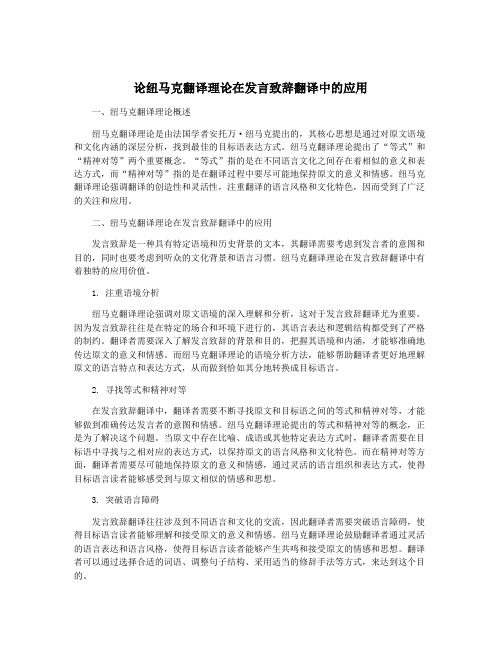
论纽马克翻译理论在发言致辞翻译中的应用一、纽马克翻译理论概述纽马克翻译理论是由法国学者安托万·纽马克提出的,其核心思想是通过对原文语境和文化内涵的深层分析,找到最佳的目标语表达方式。
纽马克翻译理论提出了“等式”和“精神对等”两个重要概念。
“等式”指的是在不同语言文化之间存在着相似的意义和表达方式,而“精神对等”指的是在翻译过程中要尽可能地保持原文的意义和情感。
纽马克翻译理论强调翻译的创造性和灵活性,注重翻译的语言风格和文化特色,因而受到了广泛的关注和应用。
二、纽马克翻译理论在发言致辞翻译中的应用发言致辞是一种具有特定语境和历史背景的文本,其翻译需要考虑到发言者的意图和目的,同时也要考虑到听众的文化背景和语言习惯。
纽马克翻译理论在发言致辞翻译中有着独特的应用价值。
1. 注重语境分析纽马克翻译理论强调对原文语境的深入理解和分析,这对于发言致辞翻译尤为重要。
因为发言致辞往往是在特定的场合和环境下进行的,其语言表达和逻辑结构都受到了严格的制约。
翻译者需要深入了解发言致辞的背景和目的,把握其语境和内涵,才能够准确地传达原文的意义和情感。
而纽马克翻译理论的语境分析方法,能够帮助翻译者更好地理解原文的语言特点和表达方式,从而做到恰如其分地转换成目标语言。
2. 寻找等式和精神对等在发言致辞翻译中,翻译者需要不断寻找原文和目标语之间的等式和精神对等,才能够做到准确传达发言者的意图和情感。
纽马克翻译理论提出的等式和精神对等的概念,正是为了解决这个问题。
当原文中存在比喻、成语或其他特定表达方式时,翻译者需要在目标语中寻找与之相对应的表达方式,以保持原文的语言风格和文化特色。
而在精神对等方面,翻译者需要尽可能地保持原文的意义和情感,通过灵活的语言组织和表达方式,使得目标语言读者能够感受到与原文相似的情感和思想。
3. 突破语言障碍发言致辞翻译往往涉及到不同语言和文化的交流,因此翻译者需要突破语言障碍,使得目标语言读者能够理解和接受原文的意义和情感。
纽马克——文本类型及翻译理论课件

• 纽马克简介
目
• 文本类型
录
• 翻译理论 • 纽马克理论的应用
• 总结
01 纽马克简介
纽马克生平
出生于1931年,英国著名翻译 家、翻译理论家
先后在英国伦敦大学、剑桥大 学学习
曾担任伦敦大学现代语言学院 翻译学教授
致力于翻译理论研究和翻译教 学,著有多部翻译理论著作
纽马克的文本类型及翻译理论为翻译研究提供了新的 视角和方法,丰富了翻译理论体系。
实践指导意义
纽马克的理论对于翻译实践具有重要的指导意义,帮 助译者更好地理解和处理不同文本类型的翻译。
跨文化交流
纽马克的理论对于跨文化交流也具有重要意义,有助 于促进不同语言和文化之间的理解和沟通。
对未来研究的启示
深入研究不同文本类型的翻译规律
01 未来研究可以进一步探索不同文本类型在翻译过程中
的特点和规律,以及如何更好地处理这些特点。
关注翻译过程中的动态变化
02 未来研究可以关注翻译过程中文本类型的动态变化,
以及如何应对这些变化。
拓展跨学科的研究视野
03
未来研究可以借鉴其他学科的理论和方法,拓展翻译研Fra bibliotek的视野和思路。
对翻译实践的指导意义
01
03
交际翻译的优点是能够使目标语读者易于理解和接受, 增强译文的交际效果,缺点是可能过于意译,导致原 文含义的损失或曲解。
04
交际翻译适用于广告、说明书、宣传册等以传达信息 为主的文本,以及新闻报道、时事评论等时效性较强 的文本。
语义翻译与交际翻译的区别
语义翻译注重对原文的忠实再现,强调 原文的语境和语义,而交际翻译注重译 文的读者反应和交际效果,强调译文的 可读性和流畅性。
纽马克翻译理论
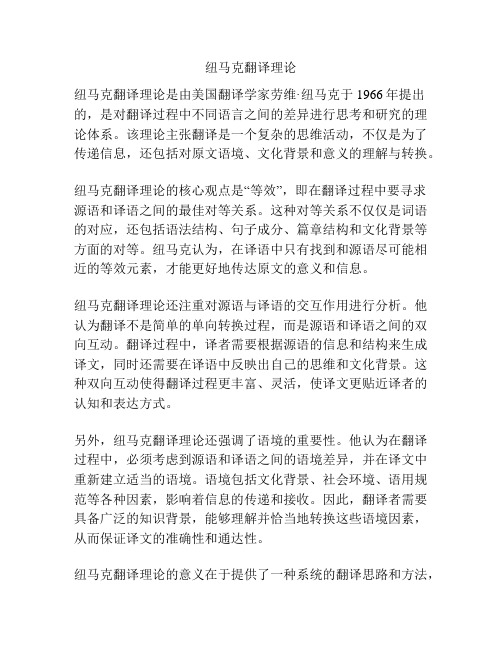
纽马克翻译理论纽马克翻译理论是由美国翻译学家劳维·纽马克于1966年提出的,是对翻译过程中不同语言之间的差异进行思考和研究的理论体系。
该理论主张翻译是一个复杂的思维活动,不仅是为了传递信息,还包括对原文语境、文化背景和意义的理解与转换。
纽马克翻译理论的核心观点是“等效”,即在翻译过程中要寻求源语和译语之间的最佳对等关系。
这种对等关系不仅仅是词语的对应,还包括语法结构、句子成分、篇章结构和文化背景等方面的对等。
纽马克认为,在译语中只有找到和源语尽可能相近的等效元素,才能更好地传达原文的意义和信息。
纽马克翻译理论还注重对源语与译语的交互作用进行分析。
他认为翻译不是简单的单向转换过程,而是源语和译语之间的双向互动。
翻译过程中,译者需要根据源语的信息和结构来生成译文,同时还需要在译语中反映出自己的思维和文化背景。
这种双向互动使得翻译过程更丰富、灵活,使译文更贴近译者的认知和表达方式。
另外,纽马克翻译理论还强调了语境的重要性。
他认为在翻译过程中,必须考虑到源语和译语之间的语境差异,并在译文中重新建立适当的语境。
语境包括文化背景、社会环境、语用规范等各种因素,影响着信息的传递和接收。
因此,翻译者需要具备广泛的知识背景,能够理解并恰当地转换这些语境因素,从而保证译文的准确性和通达性。
纽马克翻译理论的意义在于提供了一种系统的翻译思路和方法,为翻译实践提供了理论指导。
该理论强调了翻译过程中的主观能动性和交互性,强调了译者对语境的敏感度和理解力,使得翻译不再是简单的语义转换,而是一种更加复杂的思维和沟通活动。
此外,纽马克翻译理论的强调了译文的灵活性和可变性,使得翻译不再受限于严格的对等要求,而是可以根据不同翻译目的和接受者的需求进行调整和变化。
总而言之,纽马克翻译理论是对翻译过程中语言差异与等效关系的思考和研究,强调了翻译是一种复杂的思维活动,需要考虑到语境和文化背景等因素。
该理论为翻译实践提供了理论支持和指导,使译者能够更加准确地传达源语的意义和信息。
- 1、下载文档前请自行甄别文档内容的完整性,平台不提供额外的编辑、内容补充、找答案等附加服务。
- 2、"仅部分预览"的文档,不可在线预览部分如存在完整性等问题,可反馈申请退款(可完整预览的文档不适用该条件!)。
- 3、如文档侵犯您的权益,请联系客服反馈,我们会尽快为您处理(人工客服工作时间:9:00-18:30)。
Chapter 2Peter NewmarkSemantic and Communicative Translation Guided ReadingPeter Newmark (1916) is an accomplished translation scholar as well as an experienced translator. He has translated a number of books and articles and published extaensively on translation. His publications on translation include Approaches to Translation (1981), About Translation(1983), Paragraphs on Translation段落翻译(1985), A Textbook of Translation翻译教程(1988), and More Paragraphs on Translation(1993).In his work Approaches to Translation, Newmark proposes two types of translation: semantic translation语义翻译and communicative translation交际翻译. Semantic translation focuses primarily upon the semantic content of the source text whereas communicative translation focuses essentially upon the comprehension and response of receptors. This distinction results from his disapproval of Nida's assumption假定,假设,设想;假装;承担,担任that all translating is communicating, and the overriding最主要的,最优先的principle of any translation is to achieve "equivalent effect". For Newmark, the success of equivalent effect is "illusory", and that "the conflictof loyalties, the gap between emphasis on source and target languages will always remain as the overriding problem in translation theory and practice"(1981:38). To narrow the gap, Newmark 系统地阐述,确切地表达;规划,构想出formulates his concepts of "communicative translation" and "semantic translation", which in a sense从某种意义上说are similar to Nida's "dynamic equivalent translation" and "formal equivalent translation". Newmarks admits "communicative translation" is a common method and could be used in many types of translation. Nevertheless, he justifies证明……正当/有理,为……辩护the legitimacy合法性,正当;合理性,妥当;嫡出,正统of "semantic translation" in the following three aspects. Firstly, all translations depend on the three 一分为二,二分法;本质对立dichotomies, namely, the foreign and native cultures, the two languages, the writer and the translator. Hence, it is unlikely to have a universal theory that could include all these factors. Secondly, previous discussions on methods of translation, either Nida's "dynamic equivalence" or Nabokow's "literal translation", does not reflect the actual reality of translation method, for each of them either recommends one or 贬低,轻视disparages the other. Thirdly, the social factors, especially the readers of the second language, only play a partial部分的;偏爱/袒/心的role发挥部分作用in translation. Some texts, such as an expressive one, require a "semantic translation"(1981:62). It can be seen that可以看出by proposing the coexistence of "communicative translation" and "semantic translation", Newmark suggests a correlation相互关系,关联;相关性between translation method and text type.It should be pointed out that应该指出的是Newmark's semantic translation differs from literal translation直译because the former "respects context", interprets and even explains while the latter sticks very closely to source text at word and syntax level(1981:62). Literal translation, however, is held to be the best approach in both semantic and communicative translation, "provided that如果equivalent effect is secured, the literal word-for-word translation is not only the best, it is the only valid method of translation"(1981:39). Here Newmark seems to only take account of考虑到,顾及,体谅literary translation rather than non-literary translation, which is often rendered more freely in order to communicate the meaning. But he also states that when there is a conflict between semantic and communicative translation, the latter would win out胜出. For instance, it is better to render communicatively the public sign 公共标志bissiger Hund and chien mechant into beward thedog! in order to communicate efficiently the message, but not semantically as dog that bites! and bad dog!(1981:39). Nevertheless, it is difficult for a translator to follow Newmark's translation methods in practice, which should be adopted flexibly according to the specific context and text type.A Textbook of Translation is an expansion and a revision of Approaches to Translation in many aspects在很多方面. In this book, Newmark, follwing the German linguist Karl Buhler's functional theory of language, proposes three main types of texts (i.e. expressive有表现力的,富有表情的, informative提供大量资料或信息的,授予知识的and vocative呼格的) as well as methods of translating them (Chapters 4 and 5). Although he lists many translation methods from word-for-word translation to adaptation, he insists that "only semantic and communicative translation fulfill the two main aims of translation, which are first, accuracy, and second, economy". While semantic translation is used for expressive texts, communicative translation is for informative and vocative texts although he admits that few texts are purely expressive, informative or vocative. By stressing the wide applicability of these two translation methods, Newmark seems to overlook the function of other translation methods frequently adopted in translationpractice.Newmark's semantic and communicative translation ahve been quoted frequently among translation scholars. His concern about the coexistence of semantic and communicative translation shows that in his view effect-oriented translation以效果为导向的翻译such as Nida's dynamic equivalence should not be overstressed in translation practice, but is just one type of translation. Newmark's types of translation, however, are less influential than Nida's dynamic equivalence in the field of translation studies because they "raise some of the same points concerning the translation process and the importance of the TT reader译文读者" (Munday 2000:46). Further, his views and comments are still very traditional and prescriptive规定的,指定的,规范的, bearing some traces of traditional translation theories. The strength of his writing lies in that his discussion on translation covers a wide range of topics, and he always provides useful advice and guidance for translator 接受训练的人,实习生,培训生trainees with a large number of interesting and useful examples, which are more convincing than abstract theoretical arguments抽象的理论论证. The following excerpt is selected from Chapter 3 of Newmark's Approaches to Translation. In this chapter he 假定,要求postulates his twomain methods of translation (i.e. Semantic and communicative translation), and tries to apply them into different types of text. Communicative and Semantic Translation1.A translation must give the words of the original.2.A translation must give the ideas of the original.3.A translation should read like an original work.4.A translation should read like a translation.5.A translation should reflect the style of the original.6.A translation should possess the style of the translation.7.A translation should read as a contemporary of the original.8.A translation should read as a contemporary of the translation.9.A translation may add to or omit from the original.10.A translation may never add to or omit from the original.11.A translation of verse should be in prose.12.A translation of verse should be in verse.(The Air of Translation, T.H. Savory, Cape, 1968, p.54)In the pre-linguistics period of writing on translation, which may be said to date from Cicero through St. Jerome, Luther, Dryden, Tytler, Herder, Goethe, Schleiermacher, Buber, Ortega y Gasset, not to say Savory, opinion swung between literal and free, faithful and beautiful, exact and natural translation, depending on whether the bias was to be in favour of赞成the author orthe reader, the source or the target language of the text. Up to the nineteenth century, literal translation represented a philological语言学的,文献的,文学的academic exercise语言学学术活动from which the cultural reformers文化改革者were trying to rescue literature. In the nineteenth century, a more scientific approach was brought to bear on对……有影响,和……有关translation, suggesting that certain types of texts must be accurately translated, while others should and could not be translated at all! Since the rise of modern linguistics (philology语言学was becoming linguistics语言学here in the late fifties), and anticipated by预计到Tytler in 1790, Larbaud, Belloc, Knox and Rieu, the general emphasis, supported by communication-theorists as well as by non-literary translators, has been placed on the reader---on informing the reader effectively and appropriately, notably显著地,明显地;尤其,特别in Nida, Firth, Koller and the Leipzig School. In contrast 相反, the brilliant essays of Benjamin, Valery and Nabokov (anticipated by Croce and Ortega y Gasset) advocating literal translation have appeared as isolated孤立的,被隔离的, paradoxical phenomena自相矛盾的现象, relevant only to 与……有关translating works of high literary culture. Koller (1972) has stated that the equivalent-effect principle oftranslation is tending to rule out把……排除在外,排除……的可能性;不把……考虑在内all others, particularly the predominance of any formal elements such as word or structure. The apparent triumph of the "consumer" is, I think, illusory. The conflict of loyalties, the gap between emphsis on source and target language will always remain as the overriding problem in translation theory and practice. However, the gap could perhaps be narrowed if the previous terms were replaced as follows:SOURCE LANGUAGE BIAS TARGET LANGUAGE BIASLITERAL FREEFAITHFUL IDIOMATICSEMANTIC / COMMUNICATIVE Communicative translation attempts to produce on its readers an effect as close as possible to that obtained on the readers of the original. Semantic translation attempts to render, as closely as the semantic and syntactic造句法的,句子结构的structures of the second language allow, the exact contextual上下文的,前后关系上的meaning of the original.In theory, there are wide differences between the two methods. Communicative translation addresses itself solely to the second reader, who does not anticipate difficulties or obscurities, andwould expect a generous transfer of foreign elements into his own culture as well as his language where necessary. But even here the translator still has to respect and work on the form of the source language text as the only material basis for his work. Semantic translation remains within the original culture and assists the reader only in its 言外之意,涵意connotations if they constitute组/构/形成;设立,建立,任命the essential human (non-ethnic种族的,民族的,部落的) message of the text. One basic difference between the two methods is that where there is a conflict, the communicative must emphasize the "force" rather than the content of the message. Thus for Bissige Hund or Chien mechant, the communicative translation Beware of the dog! Is mandatory命令的;义务的,强制的; the semantic translations ("dog that bite", "savage dog") would be more informative but less effective. Generally, a communicative translation is likely to be smoother, simpler, clearer, more direct, more conventional依照惯例的,符合习俗的,因循守旧的;常规的, conforming to a particular register语域(在特定社交场合或专业领域中人们使用的词汇﹑语法等的范围)of language, tending to (与名)在……下面/之下;级别低于,隶属于(与形、动)不足under-translate, i.e.即,换而言之,也就是To use more generic类的,属的;一般的,通用的,hold-all terms in difficult passages. A semantic translation tends to be more complex, more awkward不灵活的,笨拙的, more detailed, more concentrated, and pursues the thought-processes 思考过程rather than the intention of the transmitter传送/递者;传输者;传播者;发射机,发射台. It tends to over-translate, to be more specific than the original, to include more meanings in its search for one nuance意义上的细微差别of meaning. However, in communicative as in semantic translation, provided that equivalent-effect in secured, the literal word-for-word translation is not only the best, it is the only valid method of translation. There is no excuse for unnecessary "同义词synonyms", let alone v.&n.释义,意译,改述paraphrases, in any type of translation.Conversely相反地, both semantic and communicative translation comply with遵照,服从the usually accepted syntactic造句法的,句子结构的equivalents (Vinay and Darbelnet's "transpositions") for the two languages in question正在谈论的. Thus, by both methods, a sentence such as "II traversa la Manche en nageant" would normally be translated as "He swam across the Channel". In semantic, but not communicative translation, any deviation背离,偏离;偏差;离题from SL 文体规范stylistic norms规范,标准would bereflected in an equally wide deviation from the TL norms, but where such norms clash, the deviations are not easy to formulate 构想出,规划;系统地阐述,确切地表达, and the translator has to show a certain tension between the writer's manner and the强迫,强制;冲动,欲望compulsions of the target language. Thus when the writer uses long complex sentences in a language where the sentence in a "literary" (carefully worked) style is usually complex and longer than in the TL, the translator may reduce the sentences somewhat, compromising between the norms of the two languages and the writer. If in doubt, however, he should trust the writer, not the "language", which is a sum of abstractions抽象的总和. A semantic translation is concrete. Thus when faced with:此处略去一段法语。
